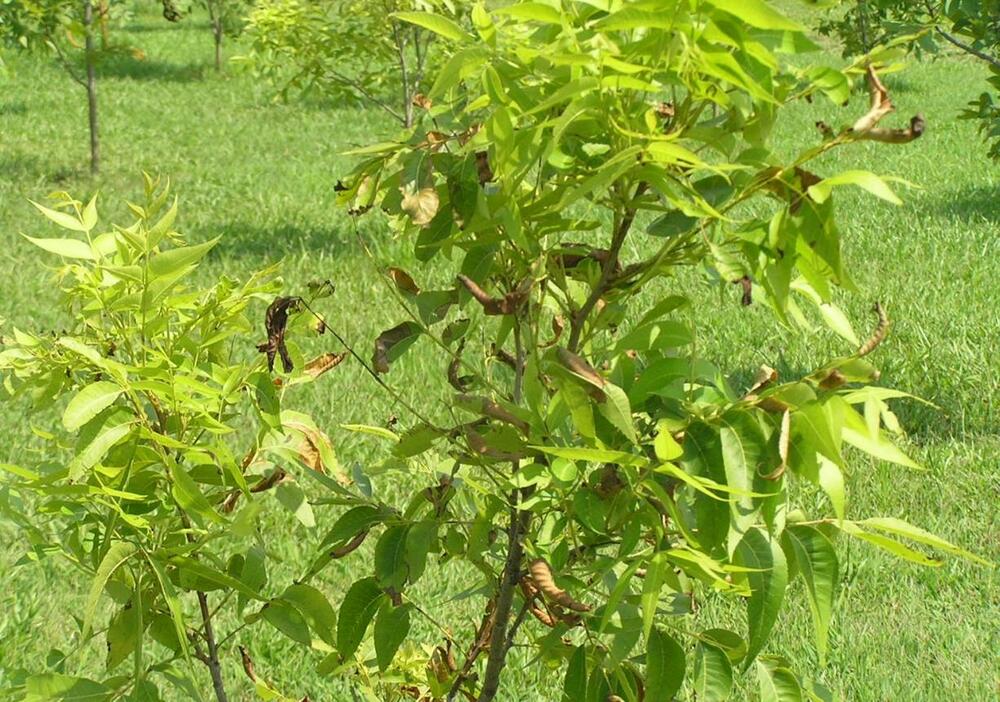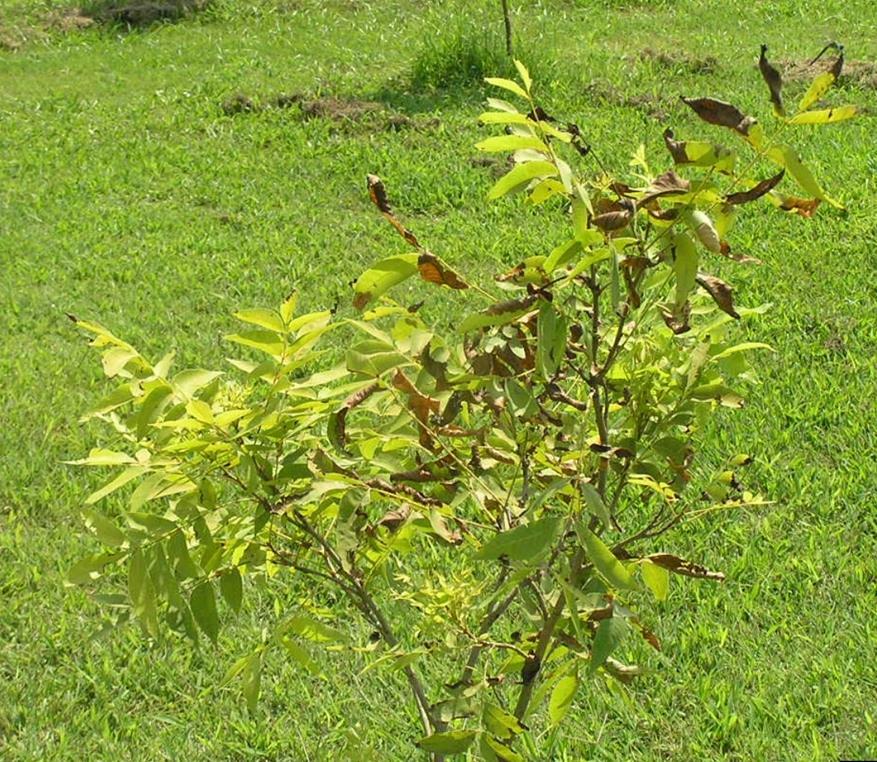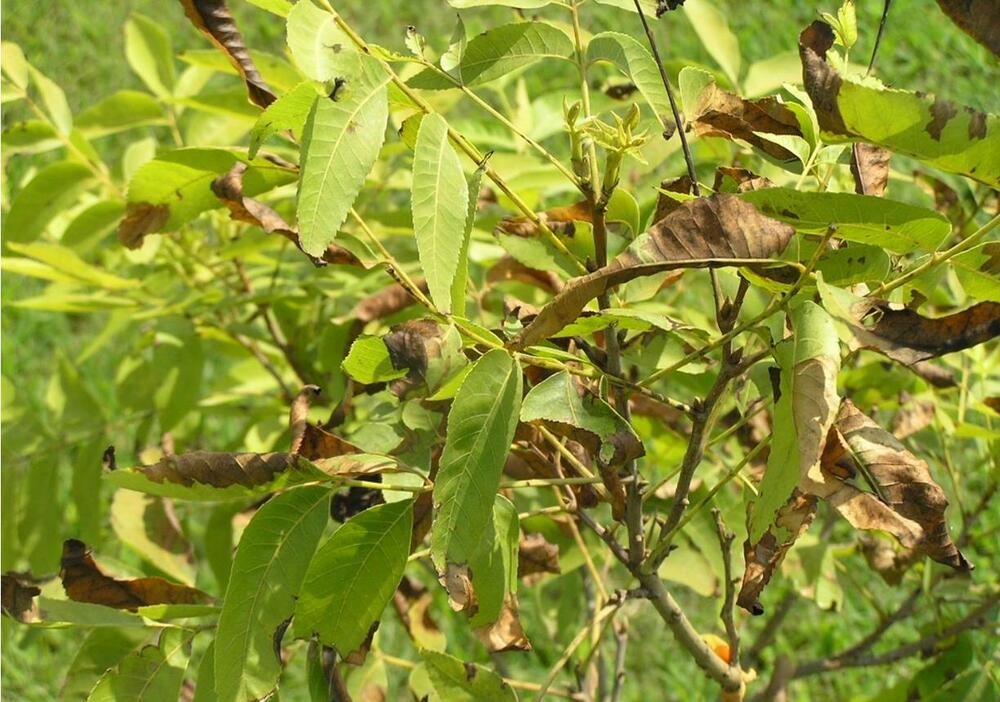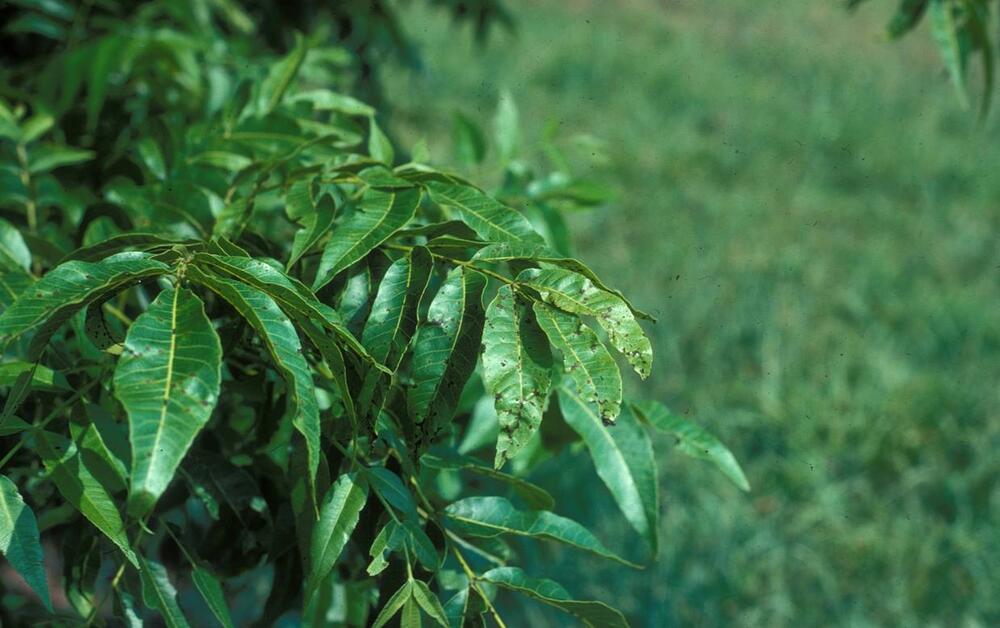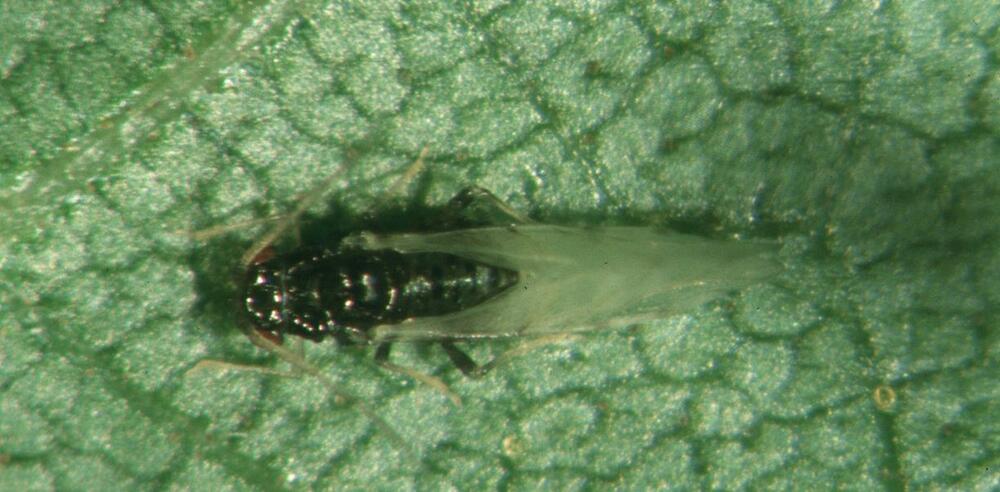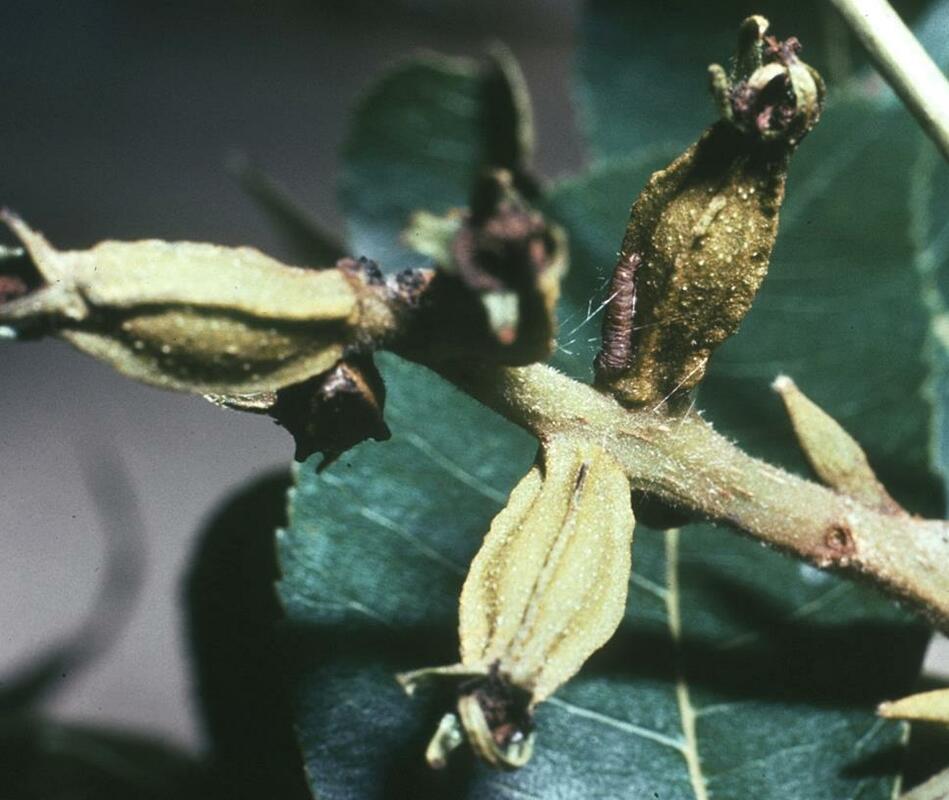Pecan
Description
Uses
Propagation
References
Common Pests and Diseases
Diseases
Category : Fungal
Anthracnose Colletotrichum gloeosporoides
Symptoms
Shiny, dark brown sunken lesions on green fruit which may coalesce to cover the whole fruit; may be pink colored fungal masses on lesions during wet weather; yield may be reduced
Cause
Fungus
Comments
Fungus overwinters on tree; disease emergence favors warm temperatures and high rainfall
Management
Disease can be controlled by regularly applying appropriate fungicides; mummified fruit and infected branches should be removed to reduce inoculum; avoid cover crops which are an alternative host for the fungus; plant anthracnose resistant varietiesDowny spot Pseudocercosporella caryigena
Symptoms
Circular, pale yellow spots on lower surface of leaves; spots may be covered with fuzzy white growth during wet; lesions develop through leaves and become visible on upper leaf surface; lesions on upper leaf surface yellow-brown; leaflets may drop from tree; nut yield may be reduced die to defoliation
Cause
Fungus
Comments
Fungus survives in infected leaves from previous season; disease occurs sporadically in Southeastern U.S. and is common in the U.S. state of Texas
Management
Downy spot is controlled by the fungicides that are applied to protect against scabPowdery mildew Phyllactinia guttata
Symptoms
Small, powdery white spots on leaves and fruit; spots spread to cover entire leaf; small black fungal fruiting bodies may be visible in the white growth; young leaflets may crinkle as they mature
Cause
Fungus
Comments
Some pecan varieties are susceptible to powdery mildew and disease is not controlled by scab fungicides and plants should be scouted for the disease over the summer months
Management
Trees showing symptoms should be treated with appropriate sulfur-containing fungicidesVein spot Gnomonia nerviseda
Symptoms
Dark brown to black lesions associated with vascular tissues e.g. along leaf veins or leaf midribs; leaves may fall from trees
Cause
Fungus
Comments
Fungus survives in plant debris on the ground
Management
Fungicide applications made to control scab should also be sufficient to control vein spot; there are some pecan varieties that are less susceptible to vein spot such as Melrose and CherokeeZonate leaf spot Grovesinia pyramidalis
Symptoms
Lesions with concentric rings on leaves which are tan to light brown on the leaf underside and gray-brown on the upper leaf surface; a crystalline substance may be present on the surface of the lesion; infected leaves dry out by late summer and drop from the tree prematurely; defoliation may be severe
Cause
Fungus
Comments
Disease can develop rapidly after wet periods in the summer months and symptoms are worse in low-lying orchards
Management
The disease can be controlled by application of appropriate fungicidesCategory : Bacterial
Bacterial leaf scorch Xylella fastidiosa
Symptoms
Tan to brown necrotic lesions with distinct dark brown line separating the diseased tissue from healthy; lesions occur on leaf margin or apex; entire leaves becoming necrotic; leaflets may drop from tree; symptoms may be confined to one limb or scattered throughout canopy
Cause
Bacterium
Comments
Vector of pathogen unknown, likely spread by xylem feeding insects
Management
Control of the disease should focus on limiting stress to the trees by providing adequate irrigation, thinning trees and controlling damaging insectsCrown gall Agrobacterium tumefaciens
Symptoms
Galls of various sizes on roots and root crown below the soil line; galls may occasionally grow on the trunk; galls are initially light colored bulges which grow larger and darken; galls may be soft and spongy or hard; if galling is severe and girdles the trunk then young trees are weakened due to constricted vascular tissue; trees may be stunted and rarely die
Cause
Bacterium
Comments
The bacterium enters host plants through wounds and causes plant cells to proliferate and cells to be undifferentiated, leading to the formation of a gall
Management
Only plant disease-free nursery stock; plant trees in well-draining soils; avoid wounding the plants as much as possible; fresh wounds can be treated with a biocontrol agent (Agrobacterium tumefaciens K84), if available, to prevent the bacterium colonizingScab Cladosporium caryigenum
Symptoms
Small, rough or velvety olive green to black spots on leaves, green twigs or fruit; lesions may coalesce to form large dark areas with an irregular shape; leaflets may drop from plant if they are infected at the base of the petiole; lesions on young leaves may dry out and crack, resulting in a "shot hole" appearance as the leaves expand; lesions on shucks are virtually identical to those on the leaves ; severe infection of fruit can cause fruit to stop developing
Cause
Fungus
Comments
Fungus overwinters in tissues infected previous year
Management
Scab is usually controlled by a series of fungicide sprays between budbreak and shell hardeningCategory : Oomycete
Shuck and kernel rot Phytophthora cactorum
Symptoms
Rotting fruit with rot starting at stem end of fruit; dark brown rot with light brown margin spreading to cover entire fruit; kernels have a dark seed coat and bitter taste
Cause
Oomycete
Comments
Disease outbreaks sporadic but can be very damaging
Management
Appropriate fungicides should be applied at first sign of infection to reduce the severity of the infection; cultural control methods include thinning the canopy to promote good air circulation around the foliage and planting pecan in well-draining soilsPests
Category : Insects
Black pecan aphid Melanocallis caryaefoliae
Symptoms
Bright yellow angular spots on leaves between veins; the spots turn brown and, if there are a few present on the leaflet; the leaflet will drop from the tree; premature dropping of leaves causes reduced nut yields; insect is small and soft bodied and ranges in color from various shades of green to black; nymphs are usually lighter in color than the adults
Cause
Insect
Comments
The characteristic stickiness of plants which is usually present during aphid infestation cannot be used as an indicator of black pecan aphid attack as this aphid does not produce honeydew
Management
Trees should be inspected for aphids regularly due to their potential to cause severe damage; an appropriate insecticide which does not harm beneficial insects should be applied to reduce the aphid populationPecan nut casebearer Acrobasis nuxvorella
Symptoms
Holes in nutlets at base which usually is associated with black frass that protrudes from the hole; frass and damaged nutlets are held together by silken thread; adult insect is a small, light gray moth; larvae are initially white with a brown head and mature to olive or jade green
Cause
Insect
Comments
Larvae pupate to adult moths within the nut; insect overwinters as larva and may undergo several generations per year with the total number determined by location
Management
The primary method of controlling the pecan nut casebearer is through the application of an appropriate insecticide; insect growth regulators are preferable to organophosphates, carbamates or pyrethroids which disrupt populations of beneficial insects; Bacillus thurengiensis can also be an effective method of controlling the moth larvae but application must be timed well in order to be effectivePecan weevil Curculio caryae
Symptoms
Adult feeding on nuts prior to nut hardening causes nuts to drop from the tree; adult feeding causes a dark brown stain where the insect's mouthparts puncture the nut shell; larvae feed inside the nuts and can completely destroy the kernels; there are often little outward symptoms of larval feeding; shucks may remain attached to the nut shell; adult insect is a light brown-gray beetle with long snout; larvae are creamy white grubs wit brown heads
Cause
Insect
Comments
Trees should be monitored closely for signs of weevil infestation, particularly in dry years or if trees have a history of weevil infestation











